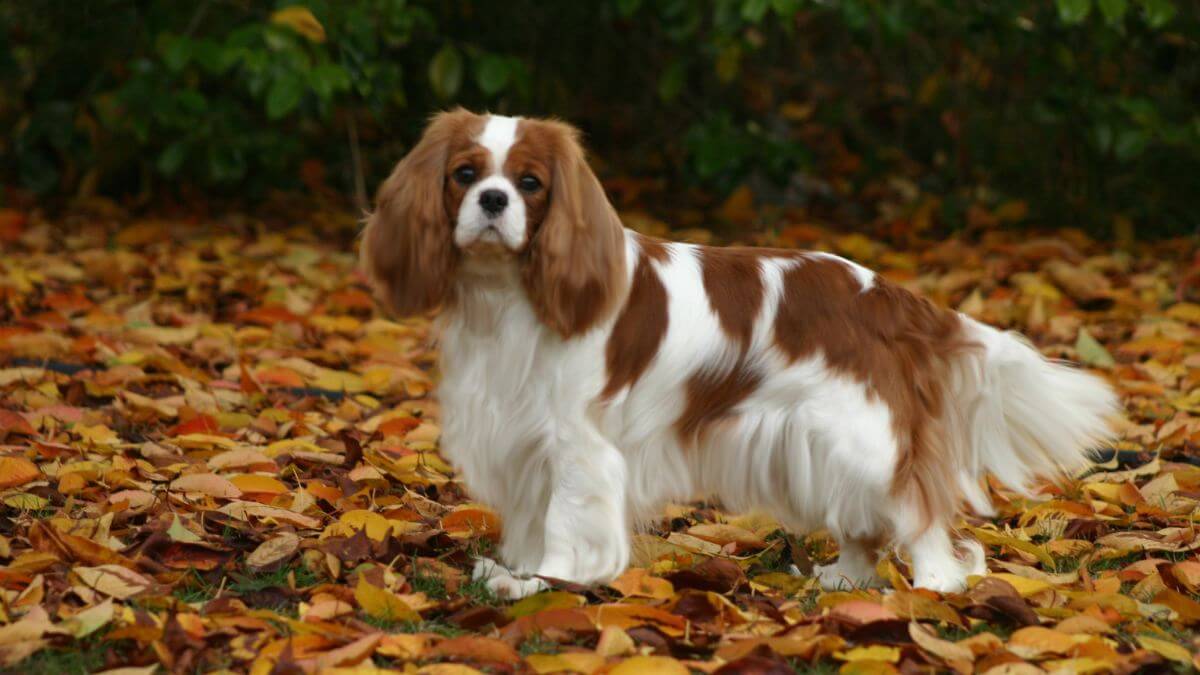


Home » Behold! – The Cavalier King Charles Spaniel

This article was originally published in Showsight Magazine, July 2013 issue.
No other breed of purebred dog has evolved amidst more drama than the Cavalier King Charles Spaniel. Small in size, gentle in nature, with a most sweet and appealing expression, toy spaniels were not uncommon in European court society in the 15th century. In 1486 Dame Juliana Berners wrote a monograph called ‘Te Boke of St. Albans’ where she included in a list of dog breeds ‘small ladyes puppees that beare awaye the fees…’ The palace physician to Queen Elizabeth I (reigned 1558-1603) called these small Spaniels ‘delicate, neat, and pretty kind of dogs, called the Spaniel comforter… These dogs are… pretty, proper, and fine, and sought for to satisfy the delicateness of dainty dames.’ (De Canibus Britannicus, 1570).
But nowhere has the Cavalier been more adored and reviled as by the English monarchs Charles I and Charles II, who championed these little dogs—and their courtiers who often found them repulsive and unsanitary even by dubious seventeenth century health standards. In 1649, the unfortunate Charles I is reputed to have lost his head to the executioner’s blade with his little spaniel dog ‘Rogue’ under his robe—the ultimate ‘comforter spaniel.’ His son and successor, Charles II, was besotted with the breed, and his dogs roamed freely throughout his palaces. The diarist John Evelyn stated ‘He took delight in having a number of little spaniels follow him and lie in his bed chamber, where he suffered the bitches to puppy…’ At his bedside when he died there were about a dozen Cavaliers.

Charles’ brother, James II, continued the royal love affair with the toy spaniels, some immortalized in the art of Van Dyck, Rembrandt, Titian, and Gainsborough—and later Maud Earl, Fragonard, Stubbs, and Landseer. The first illustrated edition of Shakespeare’s ‘Taming of the Shrew’ featured a small spaniel dog. James resumed the breeding of those animals Charles left behind. The reign of William and Mary began in 1689. They were not particularly enamored of the toy spaniel, and favored the pug. However, the little spaniels still flourished as lady’s pets and were kept popular by Mary’s sister, Henrietta. The apocryphal story of Sarah, the Duchess of Marlborough, is often cited—she allegedly pushed her thumb repeatedly on top of the head of her little red and white spaniel while nervously waiting for news of her husband fighting at the Battle of Blenheim in 1704—therefore identifying the famous ‘Blenheim spot’ still desired among breeders today.
Queen Victoria had a cherished pet tricolor named Dash who was with her at her coronation in 1838. After 1840, despite Queen Victoria’s love of the breed, the Cavalier type of toy spaniel began to fall out of favor in Britain. It was supplanted by a shorter muzzled, domed headed variation with low set ears, antithetical to the longer muzzled, flatter skulled Cavalier. Leighton’s 1907 New Book of the Dog referred to the more extreme type as ‘goggle-eyed, pug nosed, pampered little peculiarities.’ They were known as King Charles spaniels and remain a separate breed today. It is likely that breeders after 1850 may have included pugs in their breeding programs, to achieve the desired short muzzle much faster. The fortunes of the Cavalier and the King Charles spaniels share much early history and even in the nineteenth century both types were bred together. Four colors evolved—the red and white Blenheims, Tricolors, Black & Tans, and solid red Rubys.

The Cavalier not only owes his origins to a kinship with the King Charles, but he is also a product of the breeding of several different types of spaniels in the early centuries—’little cocking spaniels’ used for hunting woodcock, the somewhat larger Blenheims bred by the Duke of Marlborough (of whom it was said that they ‘should be able to go all day behind a horse’), and even the Water Spaniel as suggested in the work of Mrs. Neville Lytton published in 1911 (Toy Dogs and Their Ancestors). Although the Cavalier is keenly interested in birds and small game, there is little evidence to suggest that historically he was set to the hunt. The chief ‘duty’ of the Cavalier throughout history was as a companion. He was a small lap dog who was a cherished family member then as now. While small, ideally 13-18 lbs. and not over 13″ at the withers according to the present Breed Standard, he is not fragile. He is quite happy to go on long walks with his family or to withstand the vigorous ministrations of responsible children. While the Cavalier was nurtured, developed, feted, and loved in England, it is ironic that it was an American millionaire from New York, Roswell Eldridge, who is credited with a major role in saving it from obscurity.
Having become interested in the type that was represented by the Cavalier, as opposed to the more popular ‘Charlie,’ Mr. Eldridge offered £25 at Crufts in 1925 (and for 4 succeeding years) to winners of ‘Cavalier’ classes that he sponsored. This award stimulated a small and dedicated band of breeders to begin the difficult revival of the breed, and the Cavalier King Charles Spaniel Club in the UK was founded in 1928. Early litters were undoubtedly born of the longer nosed Charlie ‘rejects’ because it was important to select for the characteristics that had been well nigh lost—the flatter skull and higher set ears, while maintaining the large round eyes that so contribute to ideal soft expression.
Nonetheless, despite the hard work of the early breeders, the Cavalier King Charles Spaniel was not recognized as a separate breed in the UK until 1945. Today, it is the most popular Toy dog in England. The first Cavaliers in the United States were imported in the 1940s. The Cavalier King Charles Spaniel Club-USA was founded in 1954 as a registry separate from that of the American Kennel Club. It has remained an independent group that has resisted recognition of the Cavalier by the AKC. As a result, the American Cavalier King Charles Spaniel Club was founded in 1993 by former CKCSC-USA members and remains the Parent Club and custodian of the AKC breed standard. In 1996 the Cavalier was indeed recognized by the AKC as the 140th AKC breed of dog. At present there are 25 AKC regional clubs across the USA.
The Cavalier in the USA is something of a status symbol to some who have seen it on television and the movies, and remember President Reagan’s Cavalier ‘Rex’ in the White House. The Cavalier ranked 20th in AKC registrations for the year 2012, up from 40th a mere 10 years before. Breeders have understandable concerns that the characteristics that endear the Cavalier to its devotees—its affability, easy trainability, gentleness, and compatibility with other dogs—may also be responsible for increasing numbers of unwelcome puppy millers, importers, and backyard breeders—all seeking to capitalize on the relatively high price tag associated with puppy purchases across the country. Erica Venier, Orchard Hill Cavaliers, worries that ‘…because it is so vastly popular, it is easy to purchase a dog on the Internet without necessarily consulting conscientious breeders. We have a good core group of breeders who really care about health issues as well as conformation. To lose that would be to lose your heart.’ Indeed, the heart is easily touched by the personality of the Cavalier—he is difficult to anger, devoted and loyal to his family, and utterly at ease with most other friendly dogs.
If you should add a Cavalier to a room full of other Cavaliers—within 5 minutes of gentle jostling, sniffing, and adjusting, the ‘new’ dog will be an accepted member of the group. Fighting among Cavaliers is almost unknown in his totally ‘polite’ society. A gently wagging tail is a hallmark of the breed. In addition to all these attributes, the Cavalier is an ‘easy keeper’—easy to feed, and relatively easy to maintain, with a minimum of grooming and NO trimming at all. His coat is flat and silky, does shed, but also enhances his very glamorous ‘finish.’ Health issues are of great importance to Cavalier breeders around the world. Carol Williams, former President of the ACKCSC, says that her biggest health concern is ‘…Mitral Valve Disease. According to our ACKCSC {Purdue} comprehensive health survey this was the #1 killer of Cavaliers. I hope we find a genetic marker for it.’ MVD is a degenerative condition affecting the mitral valve of the heart, and its onset in the breed can be early or late. Sometimes the progression is slow, and not incompatible with long life.

But at other times it progresses rapidly and culminates in premature death. Various medications have been found effective in treating this condition. Of recent years, a neurological disorder called Syringomyelia has been identified in growing numbers and is presently being studied. SM is a progressive neurological disease in which the normal flow of spinal fluid is impeded, resulting in a variety of neurological symptoms. Pioneering surgical techniques are being developed to aid the most severe of cases. Less affected dogs live full lives with only a few symptoms such as neck scratching or head tilt. Scientists have recently developed a blood test for Curly Coat/Dry Eye syndrome, so breeders are able to recognize those dogs that are unaffected but may be genetic carriers–and breed accordingly. Cavaliers are also sometimes subject to various eye conditions, hip dysplasia, and cancers of various forms. It is a testament to the sweet and appealing nature of this unique breed that it remains so popular despite its significant health concerns. Having mentioned them here, I must also say that there are many, many robust Cavaliers that live well into their teens and enjoy a happy elder age.
Cavaliers in the USA are not only very fashionable companion pets, but also have become increasingly competitive in the show ring. Numbers required for a Major win have spiked markedly from the early days post AKC recognition. As the show ring is the place for breeders to display their best, so too it is often a reflection of the state of the breed at a given snapshot in time. According to longtime breeder Darlene Petralia (Gray Stone Cavaliers) and others to whom I spoke, some of the troublesome issues that confront breeders today, in addition to health concerns, are those relating to imbalance in the Cavalier, lack of bone, upright shoulders, and lack of rear angulation.
In spite of its popularity I hope that breeders will be able to maintain the qualities that have made it so–its handy size, sturdy conformation, meltingly soft expression and its delightful temperament, amiable and loving.’ The Cavalier is truly a winning combination of several differing but similar breeds of dogs, bred together for generations, but almost vanishing with the vagaries of the changing times. Fortuitously revived at the whim of a wealthy American in the early 20th century, they are now passionately adored by their many supporters. Indeed, the efforts of Charles I have come to a happy fruition. As Hugh Dalziel wrote in 1881 in the book British Dogs, ‘The merry monarch did many more foolish things than take under his royal care and favor, and thereby raising to court, the beautiful toy spaniel which still bears his name.